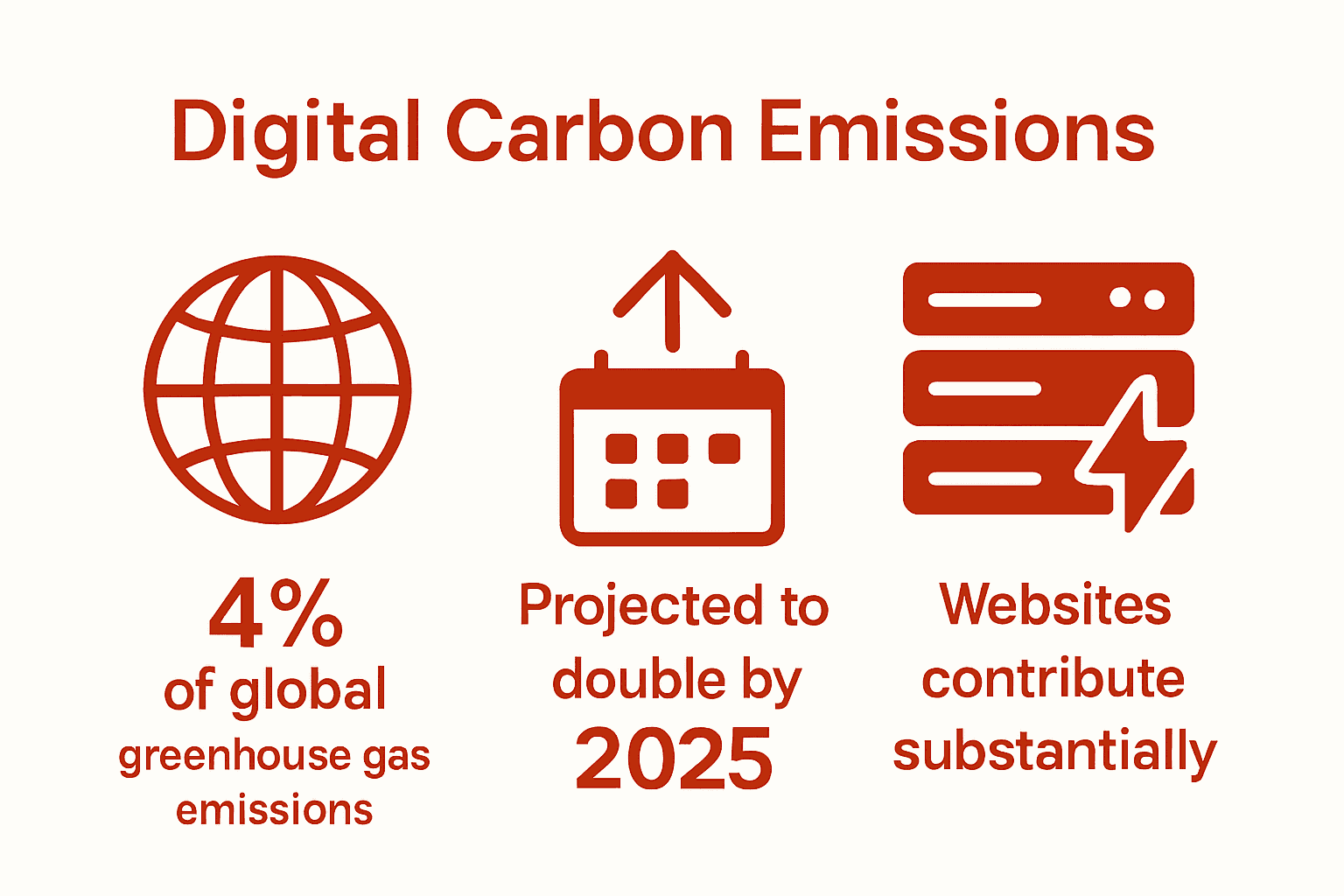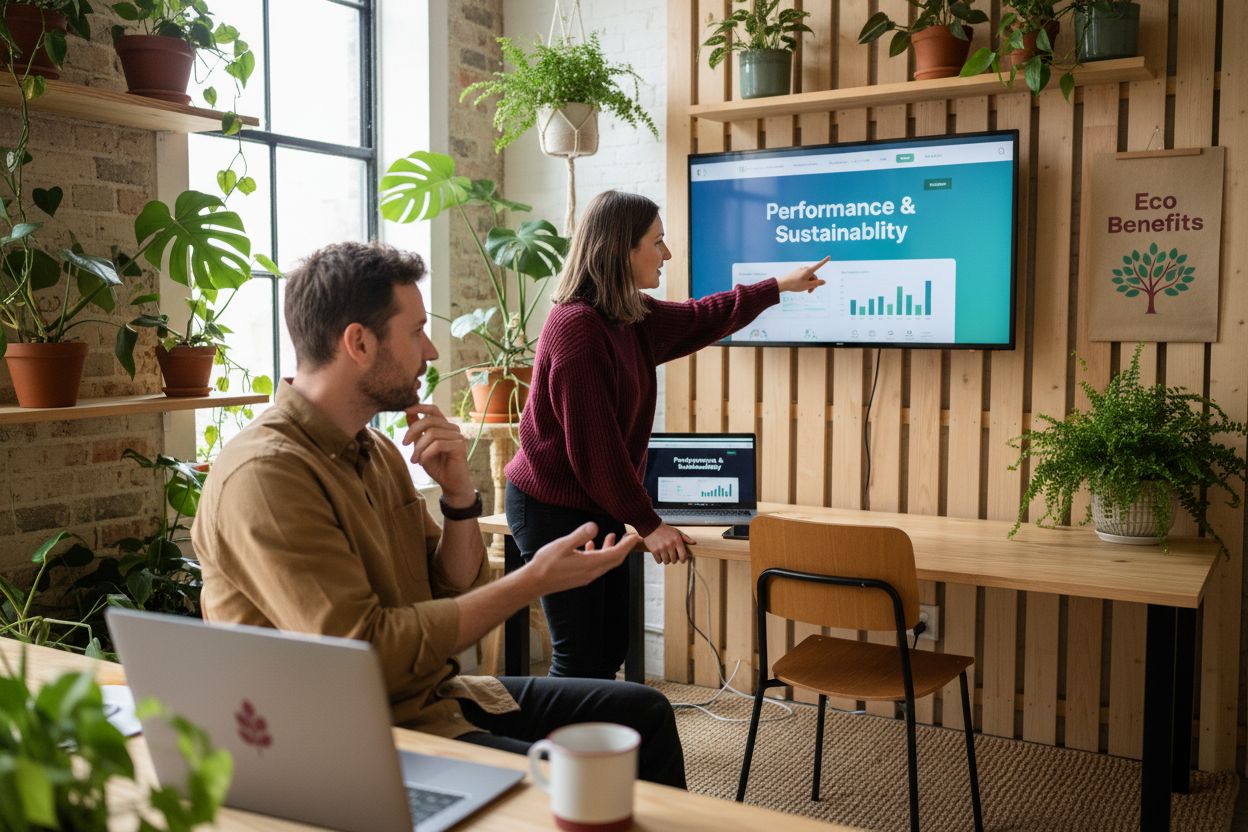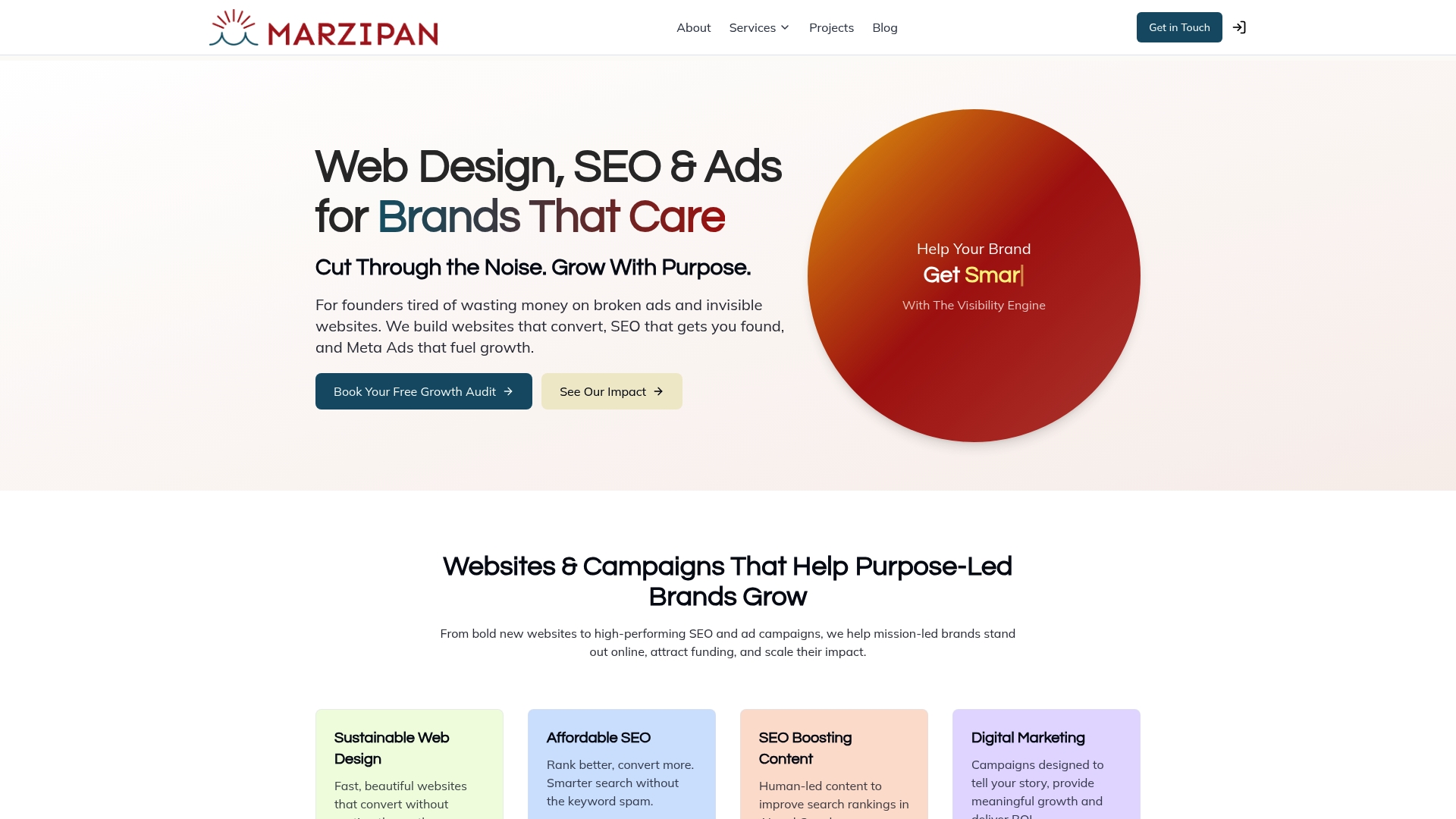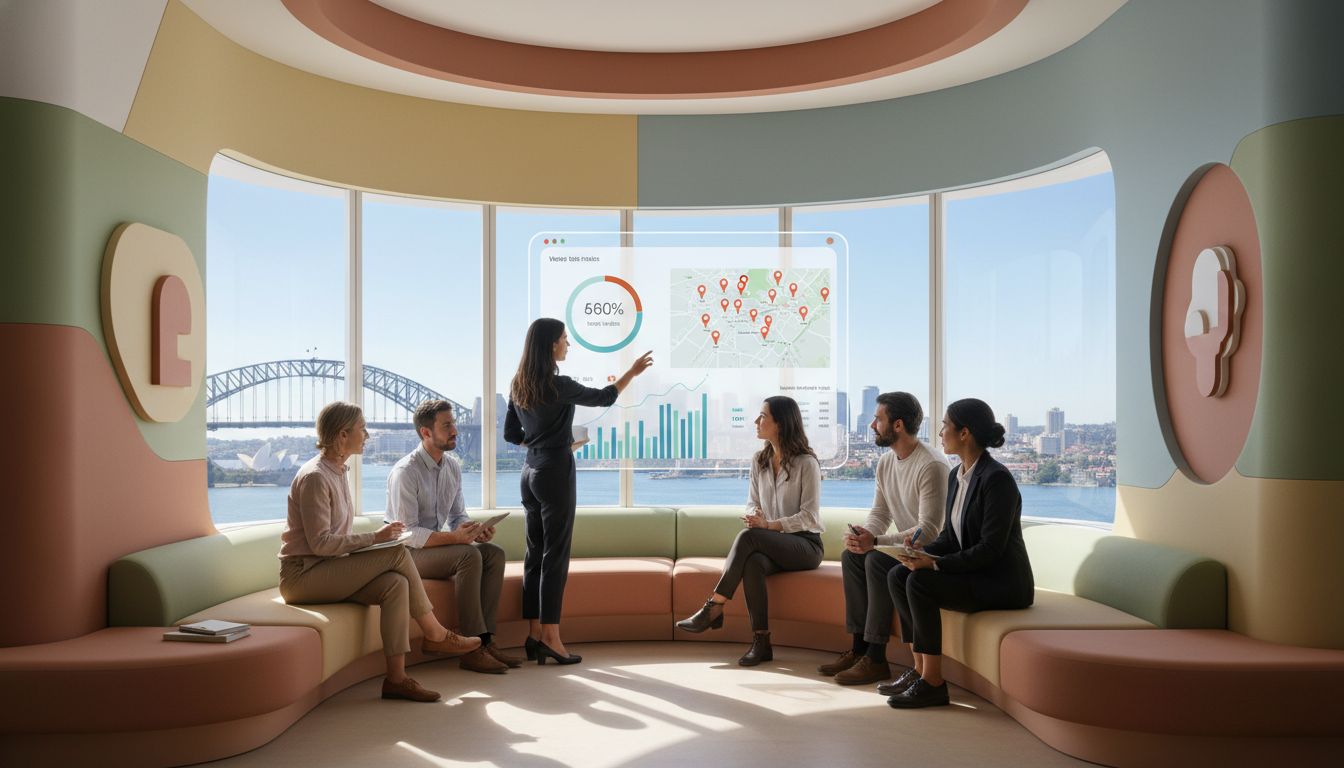Understanding Eco Web Design: Principles and Importance
Websites draw power every time we visit them and this silent energy drain stacks up fast. Digital technologies already account for about 4 percent of global greenhouse gas emissions and this figure could double by 2025. The real surprise? Every click and scroll contributes to the internet’s invisible carbon footprint much more than most people realise. A radical new approach called eco web design promises to turn that around using smart strategies that make digital experiences sleek and sustainable at the same time.
Table of Contents
- Defining Eco Web Design: Key Principles And Concepts
- The Importance Of Eco Web Design In Today’s World
- How Eco Web Design Works: From Theory To Practice
- Sustainable Practices In Eco Web Design
- Real-World Benefits And Impact Of Eco Web Design
Quick Summary
| Takeaway | Explanation |
|---|---|
| Embrace minimalistic design | Streamline website code and graphics to reduce energy consumption. |
| Use energy-efficient coding | Develop lightweight scripts that require less processing power for better efficiency. |
| Implement optimised resource loading | Adopt techniques to minimise unnecessary data transfers, enhancing performance. |
| Select green hosting options | Choose data centres powered by renewable energy to diminish your digital carbon footprint. |
| Focus on user experience | Create faster and more responsive websites to improve user satisfaction and engagement. |
Defining Eco Web Design: Key Principles and Concepts
Eco web design represents an innovative approach to digital development that prioritises environmental sustainability and energy efficiency in website creation. At its core, this methodology seeks to minimise the carbon footprint of digital platforms by reimagining how websites consume computational resources.
The Environmental Impact of Digital Infrastructure
Digital infrastructure has a significant environmental consequence that many people overlook. Research from the Shift Project reveals that digital technologies currently account for approximately 4% of global greenhouse gas emissions. Websites contribute substantially to this impact through energy-intensive servers, complex coding structures, and excessive data transmission.
Core Principles of Sustainable Web Design
Eco web design operates on several fundamental principles designed to reduce digital environmental impact:
- Minimalistic Design: Creating lean websites with streamlined code and reduced graphical complexity
- Energy-Efficient Coding: Developing lightweight scripts that require minimal processing power
- Optimised Resource Loading: Implementing techniques that reduce unnecessary data transfers
By integrating these principles, web designers can significantly decrease a website’s energy consumption. Learn more about our sustainable web design approach to understand how technological innovation can coexist with environmental responsibility.
The approach goes beyond simple aesthetic considerations, transforming web development into a practice that acknowledges its broader ecological implications.
Below is a comparison table outlining the core principles of sustainable web design, providing concise explanations for each principle to support understanding of their individual impact.
| Principle | Explanation |
|---|---|
| Minimalistic Design | Lean websites with streamlined code and reduced graphical complexity |
| Energy-Efficient Coding | Lightweight scripts requiring minimal processing power |
| Optimised Resource Loading | Reducing unnecessary data transfers to enhance website efficiency |
| Green Hosting Selection | Choosing data centres powered by renewable energy sources |
| Efficient Content Delivery | Using advanced caching and content distribution networks for optimal performance |
| Web designers adopting eco web design principles actively contribute to reducing global digital carbon emissions while maintaining high-performance digital experiences. |
The Importance of Eco Web Design in Today’s World
In an era of increasing digital transformation and environmental awareness, eco web design emerges as a critical strategy for reducing the internet’s carbon footprint. While digital technologies have revolutionised global communication, they simultaneously contribute significantly to environmental challenges.
Understanding Digital Carbon Emissions
Research from The Conversation highlights that digital technologies currently generate approximately 4% of global greenhouse gas emissions, a figure projected to double by 2025. Websites, data centres, and network infrastructure consume substantial electricity, predominantly sourced from non-renewable energy.

Strategic Environmental Benefits
Eco web design offers multifaceted environmental advantages that extend beyond simple carbon reduction:
- Energy Conservation: Minimising computational resources required for website functionality
- Resource Efficiency: Reducing unnecessary data transmission and storage requirements
- Long-term Sustainability: Creating digital infrastructure with reduced environmental impact
Explore our sustainability initiatives to understand how technological innovation can align with environmental responsibility. By adopting eco web design principles, organisations can demonstrate corporate environmental commitment while maintaining high-performance digital experiences.
Moreover, eco web design is not just an environmental imperative but increasingly a competitive differentiator. Consumers and businesses are becoming more environmentally conscious, recognising that digital solutions can be both technologically advanced and ecologically responsible. The future of web development lies in creating digital experiences that respect our planet’s finite resources.
How Eco Web Design Works: From Theory to Practice
Transforming eco web design principles into practical implementation requires a comprehensive understanding of digital resource management and strategic technological choices. This approach goes beyond theoretical concepts, providing concrete methodologies for reducing digital environmental impact.
Technical Strategies for Sustainable Web Development
Research from IEEE demonstrates that sustainable web development involves multiple interconnected technical strategies. Web developers must focus on optimising code efficiency, reducing unnecessary computational processes, and minimising data transfer requirements.
Key Implementation Techniques
Eco web design materialises through several critical technical interventions:
- Code Minimisation: Writing lean, efficient JavaScript and CSS that reduces processing requirements
- Image Optimisation: Compressing visual assets and using modern formats like WebP to decrease file sizes
- Efficient Caching: Implementing intelligent caching mechanisms that reduce repeated server requests
Check out our web design articles for deeper insights into sustainable digital practices. The goal is creating websites that deliver exceptional user experiences while maintaining minimal environmental impact.
Practical eco web design represents a holistic approach combining technical expertise, environmental consciousness, and user-centric design principles. By reimagining web development as a practice that prioritises both performance and planetary responsibility, developers can create digital solutions that are genuinely sustainable and forward-thinking.
Sustainable Practices in Eco Web Design
Sustainable web design transcends traditional development approaches by integrating environmental consciousness into every aspect of digital infrastructure. This holistic methodology demands strategic interventions that minimise computational resources and reduce carbon emissions across website lifecycle.
Comprehensive Resource Management
Research from Sustainable Web Design reveals that effective sustainable practices involve meticulous attention to digital resource consumption. Web developers must critically analyse every element of website architecture, from code complexity to data transmission efficiency.
Core Sustainable Design Strategies
Successful eco web design incorporates multiple interconnected strategies that collectively reduce environmental impact:
- Minimalist Design Approach: Eliminating unnecessary graphical elements and complex animations
- Green Hosting Selection: Choosing data centres powered by renewable energy sources
- Efficient Content Delivery: Implementing advanced caching mechanisms and content distribution networks
Learn more about our sustainable design approach to understand how technological innovation can coexist with environmental responsibility. By adopting these practices, web designers transform digital platforms into environmentally conscious communication tools.
The ultimate goal of sustainable web design extends beyond reducing carbon footprint. It represents a fundamental reimagining of digital infrastructure as a responsible, thoughtful ecosystem that respects planetary limitations while delivering exceptional user experiences. Web professionals who embrace these principles are not just technical experts but environmental stewards in the digital landscape.
Real-World Benefits and Impact of Eco Web Design
Eco web design transcends theoretical environmental considerations, delivering tangible benefits for businesses, users, and global sustainability efforts. By reimagining digital infrastructure through an ecological lens, organisations can achieve significant operational and reputational advantages.
Economic and Performance Advantages
Research from the Green Web Foundation demonstrates that sustainable web design directly correlates with improved website performance and reduced operational costs. Lightweight, efficient websites consume less server resources, resulting in faster loading times and reduced hosting expenses.
Multifaceted Organisational Benefits
Companies implementing eco web design strategies experience several strategic advantages:
- Enhanced Brand Reputation: Demonstrating genuine environmental commitment
- Improved User Experience: Creating faster, more responsive digital platforms
- Reduced Operational Expenditure: Minimising computational resource consumption
Discover our sustainable web solutions to understand how technological innovation can drive environmental responsibility. Organisations that prioritise eco web design position themselves as forward-thinking entities committed to meaningful environmental stewardship.
This table summarises the real-world organisational benefits of implementing eco web design, helping illustrate the practical value for businesses adopting sustainable digital strategies.
| Benefit | Description |
|---|---|
| Enhanced Brand Reputation | Demonstrating genuine environmental commitment |
| Improved User Experience | Creating faster, more responsive digital platforms |
| Reduced Operational Expenditure | Minimising computational resource consumption |
| Lower Hosting Costs | Efficient websites use fewer server resources, saving money |
| Competitive Differentiation | Standing out as an environmentally conscious organisation |
Beyond immediate organisational benefits, eco web design contributes to global sustainability by systematically reducing digital infrastructure’s carbon footprint. Each efficiently designed website represents a small yet significant step towards mitigating climate change, showcasing how technological innovation can harmonise with environmental preservation.

Ready to Lower Your Digital Carbon Footprint?
Understanding the true impact of web design is eye-opening. If you have realised your current website loads slowly, consumes unnecessary resources, or does not reflect your eco values, it is time to take action. The article highlights how minimalistic design and efficient coding can reduce emissions and improve both performance and reputation. Many businesses struggle to align their digital presence with sustainability while maintaining a high-quality user experience. But you do not have to compromise.

Build a website that truly reflects your commitment to the planet. Explore how Marzipan’s sustainable web solutions reduce your environmental impact whilst improving operational efficiency. Do not wait to show your clients and community you embrace meaningful change. Visit our main site to get started on your eco web journey today.
Frequently Asked Questions
What is eco web design?
Eco web design is an approach to website development that prioritises environmental sustainability by minimising the carbon footprint and reducing energy consumption in digital platforms.
Why is eco web design important?
Eco web design is crucial for decreasing the internet’s carbon footprint, as digital technologies currently account for 4% of global greenhouse gas emissions. This approach helps create a more sustainable digital environment.
What are the core principles of sustainable web design?
The primary principles of sustainable web design include minimalistic design, energy-efficient coding, and optimised resource loading, all aimed at reducing energy consumption and improving resource efficiency.
How can eco web design benefit businesses?
Implementing eco web design can enhance brand reputation, improve user experience through faster loading times, and reduce operational costs by minimising resource consumption.







